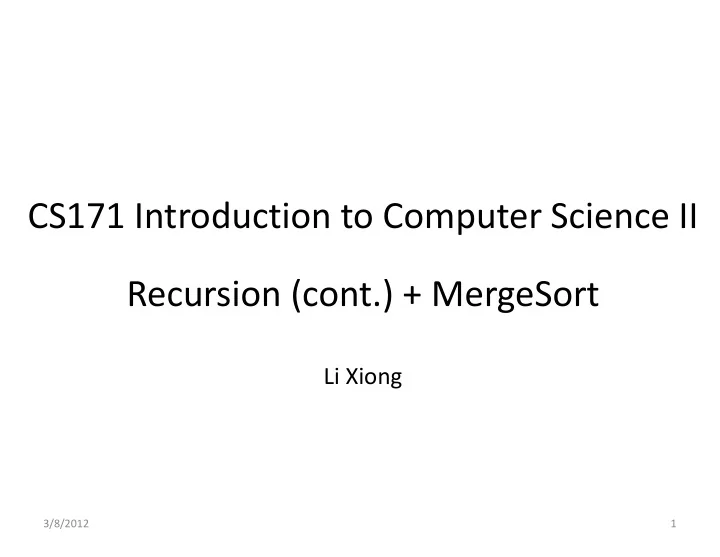

CS171 Introduction to Computer Science II Recursion (cont.) + MergeSort Recursion (cont.) + MergeSort Li Xiong 3/8/2012 1
Reminders � Hw3 due yesterday (use late credit if needed) � Hw4 due Friday 3/8/2012 2
Today � Recursion (cont.) � Concept and examples � Analyzing cost of recursive algorithms � Divide and conquer � Divide and conquer � Dynamic programming � MergeSort 3/8/2012 3
Fibonacci Numbers � Recursive formula: � � � � = � � � − �� + � � � − �� � ��� = �� � ��� = � � 0, 1, 1, 2, 3, 5, 8, 13, …..
Fibonacci Numbers ��� ����� �� � �� ������ ������ �� ���� �� ������ ���� �� ������ ������ �� ���� ������ �������������� � ���������������������������� ����!
Runtime of Recursive Fibonacci ����� ������� ������ ����� ����� ����� ����� ����� ���������������������� ���� ��������� 3/8/2012 6
Dynamic programming � Dynamically solve a smaller problem � Solve each small problem only once � Applicable when � Overlapping subproblems are slightly smaller (vs. � Overlapping subproblems are slightly smaller (vs. divide and conquer) � Optimal substructure: the solution to a given optimization problem can be obtained by the combination of optimal solutions to its subproblems.
Memoization � A technique for dynamic programming � A memoized function "remembers" the results corresponding to some set of specific inputs. � Subsequent calls with remembered inputs return the remembered result, rather than recomputing it remembered result, rather than recomputing it � General structure ���������� ���������������������������������������� ������� ������������������ !��" ��������!��������������� �����������!�� �������������#�������������� �$����%������#������������������!�� &
Fibonacci with Dynamic Programming ���������� ������ ���������� ����� ���" �����������'�(���������)�������*������*+ �������������� �����,,(��" Example: F(5) �������,��� ��������� ��������� & ����������,,���" �������,��� ��������� & �����" �������,����)���-����)��� �������������� & &
Today � Recursion (cont.) � Concept and examples � Analyzing cost of recursive algorithms � Divide and conquer � Divide and conquer � Dynamic programming � MergeSort 3/8/2012 10
Advanced Sorting � We’ve learned some simple sorting methods, which all have quadratic costs. � Easy to implement but slow. � Much faster advanced sorting methods: � Merge Sort � Quick Sort � Radix Sort
MergeSort � Basic idea � Divide array in half � Sort each half (how?) � Merge the two sorted halves � Merge the two sorted halves
Merge Sort � This is a divide and conquer approach: � Partition the original problem into two sub- problems; � Use recursion to solve each sub-problem; � Sub-problem eventually reduces to base case; � The results are then combined to solve the original problem.
Merge Two Sorted Arrays � A key step in mergesort � Assume arrays A ������������ and B ������������� are already sorted . � Merge them to array C (the original array), such as C contains all elements from A and B, and remains sorted elements from A and B, and remains sorted � Use an auxiliary array aux[] � Example on board and demo
Merging Two Sorted Arrays 1. Start from the first elements of A and B; 2. Compare and copy the smaller element to C; 3. 3. Increment indices, and continue; Increment indices, and continue; 4. If reaching the end of either A or B, quit loop; 5. If either A (or B) contains remaining elements, append them to C.
Merging Two Sorted Arrays: Analysis � How many comparisons is required? � How many copies?
Merging Two Sorted Arrays (Sol.) � How many comparisons is required? at most (A.length + B.length) � How many copies? A.length + B.length
Divide
Divide
Divide
Conquer
Conquer
Conquer
First base case encountered
Return, and continue
Merge
Merge
Merge
Merge Sort Analysis Cost Analysis � What’s the cost of mergesort? � Recurrence relation: T(N) = 2*T(N/2) + N O(N*logN) This is called log-linear cost.
Merge Sort Is this a lot better than simple sorting? # of elements N^2 N logN 10 100 10 100 100 10,000 10,000 200 200 1,000 1,000,000 3,000 10,000 100,000,000 40,000 … … …
Divide and Conquer
Bottom-up MergeSort 1. Every element itself is trivially sorted; 2. 2. Start by merging every two adjacent elements; Start by merging every two adjacent elements; 3. Then merge every four; 4. Then merge every eight; 5. … 6. Done.
Summary � Merging two sorted array is a key step in merge sort. � Merge sort uses a divide and conquer approach. � It repeatedly splits an input array to two sub-arrays, sort each sub-array, and merge the two. � It requires O(N*logN) time. � It requires O(N*logN) time. � On the downside, it requires additional memory space (the workspace array).
Recommend
More recommend